
Getting the smile you deserve doesn’t have to break the bank. There are several affordable options to straighten teeth, from snap-on veneers to clear aligners. We highlight six different methods to straighten teeth, and their price points, so you can find an option that works for you and smile more confidently.
Shiny Smile snap-on veneers are the cheapest solution for achieving straight looking teeth, followed by clear aligners and metal braces.
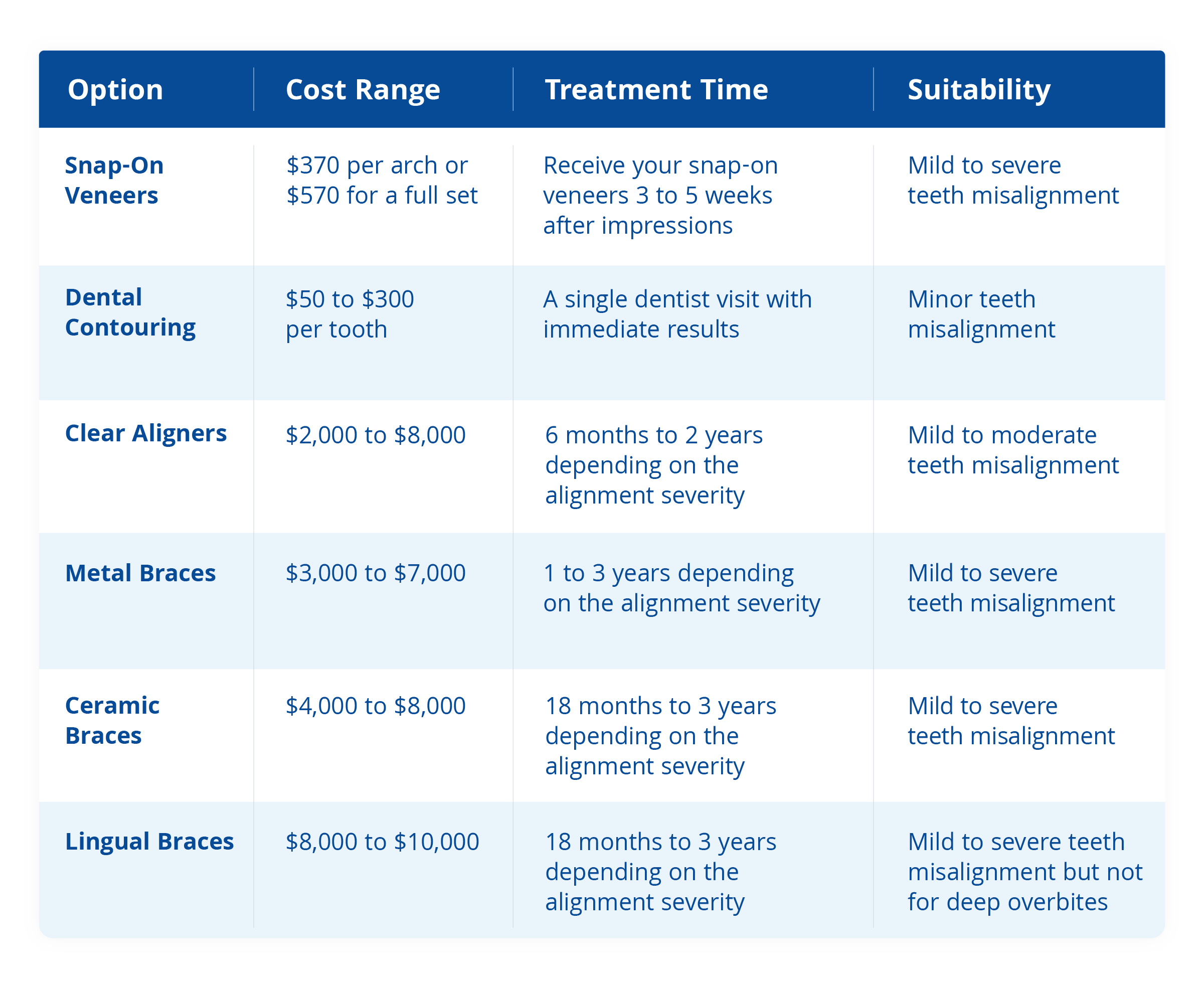
Snap-On Veneers
Snap-on veneers are a type of custom-made dental appliance that fits over your existing teeth to cover imperfections, so they can give you the appearance of straight teeth. They’re the most affordable treatment on the list.
You don’t have to visit the dentist to get them, which makes it a less time-consuming (and painful) process compared to other teeth straightening treatments. Snap-on veneers are a good option if you have mild to moderate misalignment.
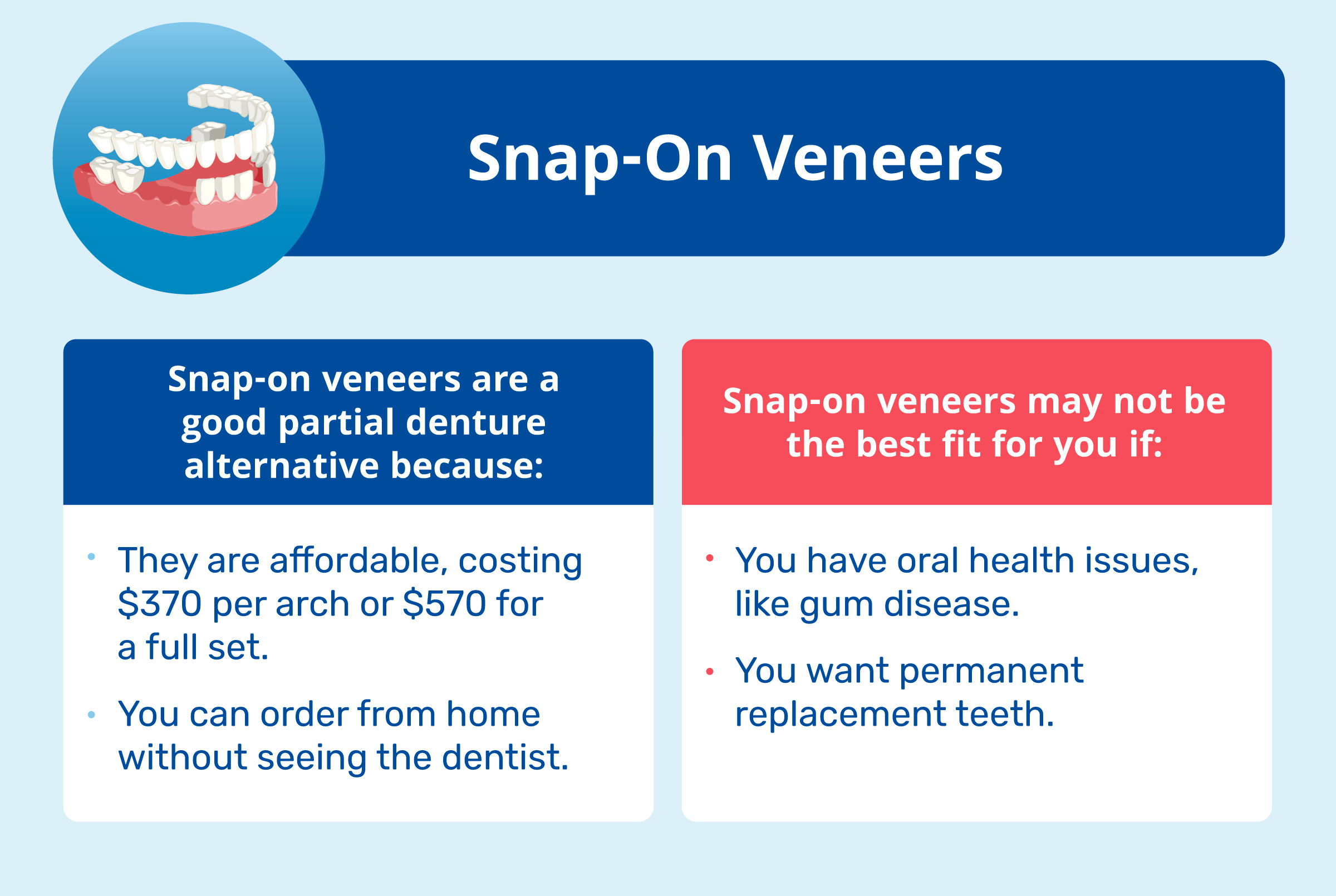
The process: You have zero dentist or orthodontist appointments. You order the impression kit, take impressions and photos of your mouth at home, and then send the impressions back. You’ll receive your snap-on veneers in the mail in three to five weeks.
- Cost range:
- $370 for one arch or $570 for a full set
- One payment, two payments, or monthly payment options available
- Not covered by insurance
- Timeline:
- Receive your snap-on veneers in 3 to 5 weeks so you can smile away!
- Receive your snap-on veneers in 3 to 5 weeks so you can smile away!
- Upkeep:
- You need to remove them before sleeping and wash them after eating.
- Avoid eating hard or chewy foods with them in, to avoid damaging them.
Dental contouring
Dental contouring reshapes teeth by removing enamel. It is often used in conjunction with dental bonding, a procedure where dentists apply and sculpt composite material to alter the teeth’s shape and appearance.
Dental contouring and bonding may be used if one or a few teeth that are crooked or uneven. It’s not a good option if you have severe tooth misalignment—it’s more suited for patients who have a few crooked teeth they want to correct.
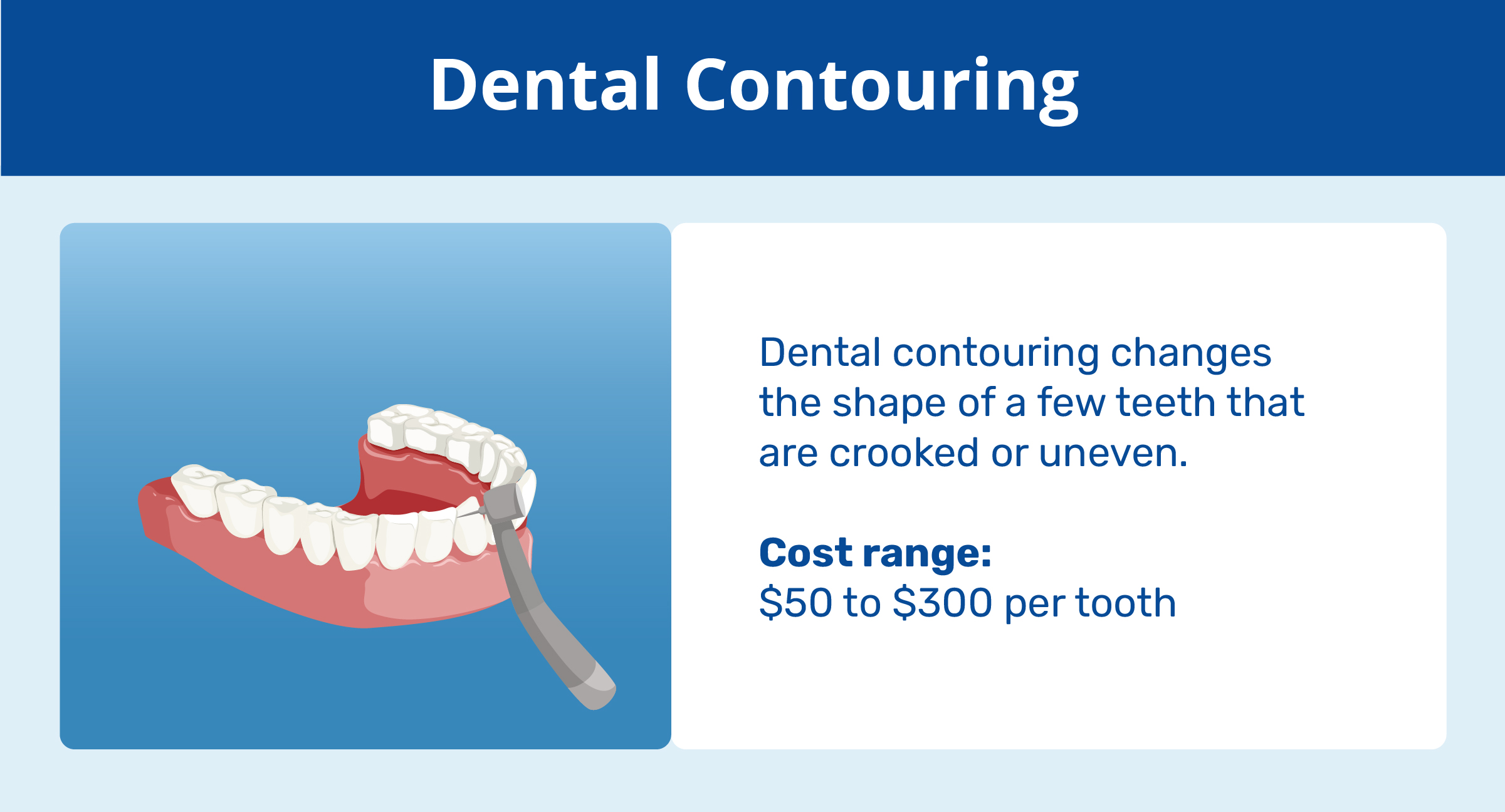
The process: Some of the tooth enamel is removed, and then your tooth is shaped or lengthened. To give your tooth an ideal shape, dentists can even add a bonding material, consisting of tooth-colored resin. The process is quick and only takes 30 minutes to an hour.
- Cost range:
- $50 to $300 per tooth
- Payment plans may be available with your dentist
- Not typically covered by insurance
- Timeline:
- 1 day
- 1 day
- Upkeep:
- Maintain your oral health by flossing and brushing daily, for the contoured teeth to last several years.
Clear Aligners
Clear aligners are a transparent, removable device that gradually straighten teeth. Patients use a series of trays, which are typically changed about every two weeks, to straighten their teeth over time.
They’re a popular choice due to their invisibility and convenience. Invisalign is one of the most popular brands, but there are many Invisalign alternatives like Byte and SmileDirectClub, that you can get quotes from.
Clear aligners are a good option for correcting mild to moderate misalignment.
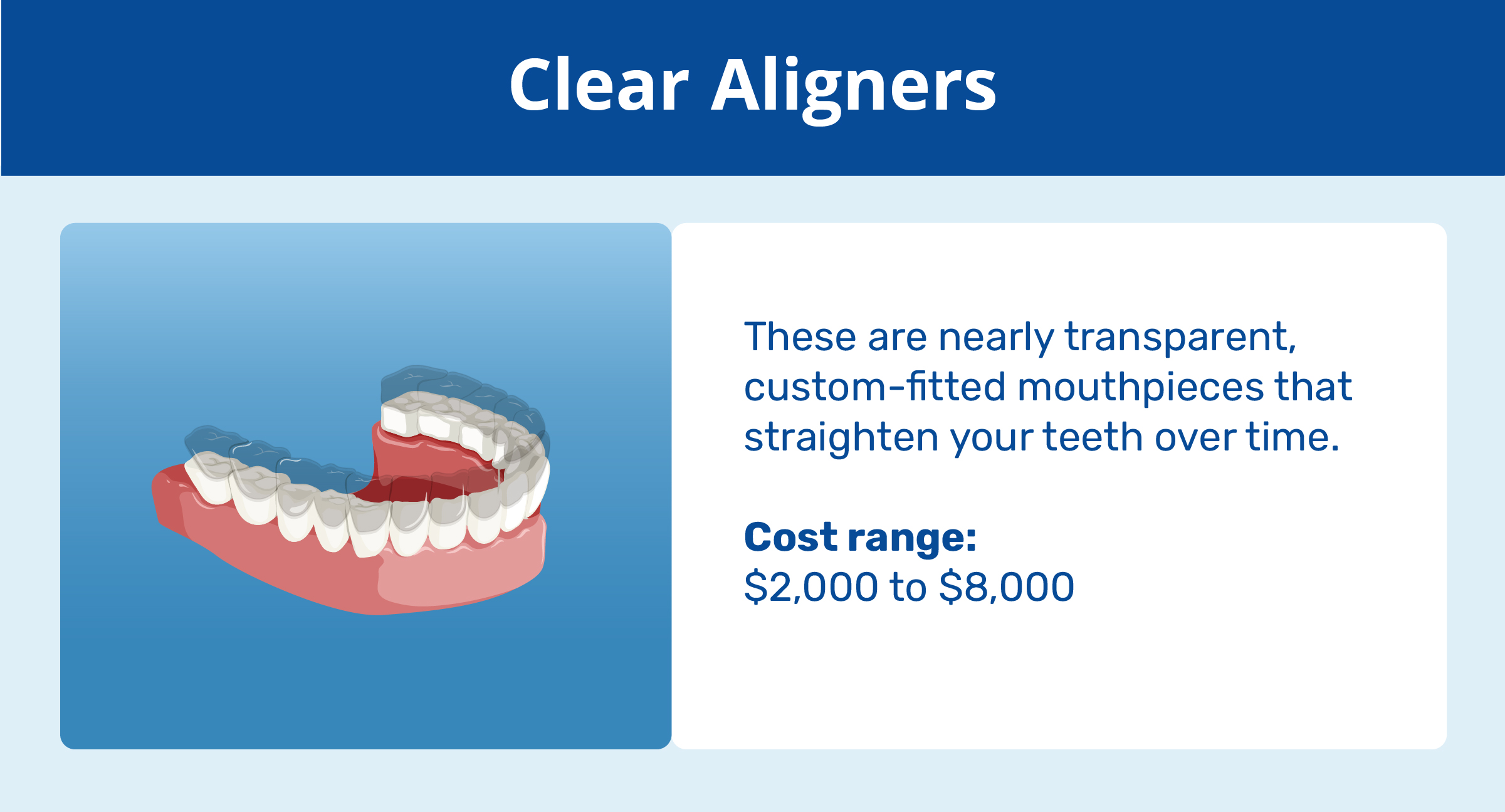
The process: Some aligner companies, like Byte, offer at-home teeth straightening services, where you take impressions at home, mail them in, and then receive your aligners in the mail. Other clear aligner brands, like SureSmile, have you go in-person to a partnering dentist where they’ll take your impressions using digital scans and then have your aligners made.
- Cost range:
- $2,000 to $8,000 depending on your teeth’s misalignment
- Common brands — Byte night aligners up to $2,399; SureSmile up to $5,000; and Invisalign up to $7,000
- Can be partially covered by dental insurance, FSA, or HSA.
- Timeline:
- 6 months to 2 years with regular alignment adjustments every two weeks based on your teeth’s misalignment
- 6 months to 2 years with regular alignment adjustments every two weeks based on your teeth’s misalignment
- Upkeep:
- You’ll usually have to go in to see your dentist every two weeks, or regularly receive new aligners in the mail, to gradually straighten your teeth over time.
- Regular check-ups with your orthodontist may be required to keep your teeth straight.
Metal Braces
Braces work by applying continuous pressure to the teeth over an extended period, gradually moving them into their desired positions. Brackets are glued to the teeth and an archwire connects each bracket together—the wire is tightened over time to align your teeth. Your orthodontists may also use bands to correct issues like an overbite.
This is a good option if you have mild to severe misalignment, but the average treatment time is 18 to 24 months.
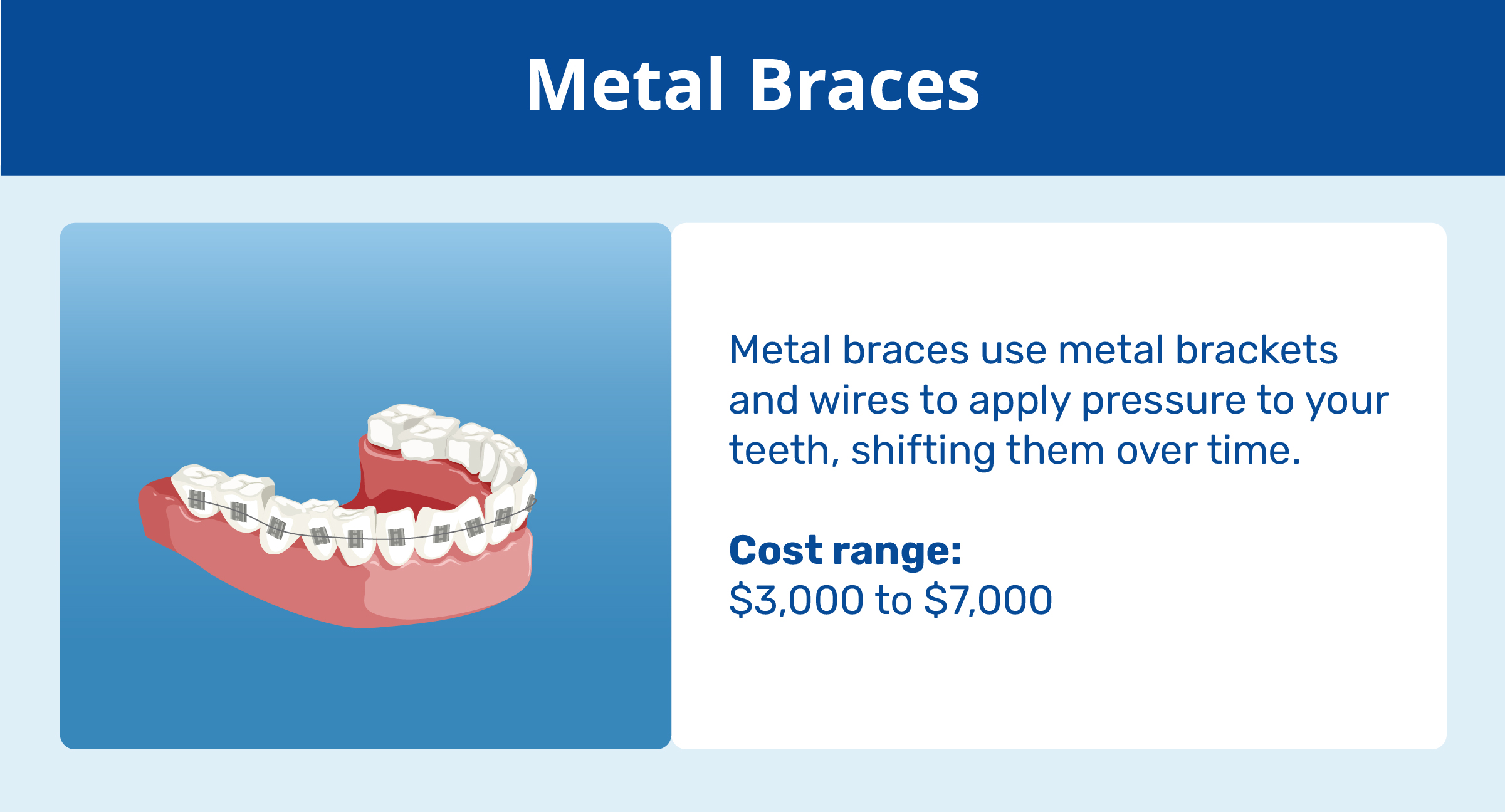
The process: You see an orthodontist for the consultation, braces fitting, and regular monthly appointments for wire adjustments that continue to add pressure to your teeth.
- Cost range:
- $3,000 to $7,000 depending on your teeth misalignment
- May be partially covered by dental insurance, FSA, or HSA
- Timeline:
- 1 to 3 years, depending on the severity of your issues, with regular weekly visits for adjustments
- 1 to 3 years, depending on the severity of your issues, with regular weekly visits for adjustments
- Upkeep:
- You’ll need to visit your orthodontist monthly to get the wires adjusted to keep your teeth straight.
- You need to maintain good dental health habits, such as brushing and flossing.
- When treatment is finished, you will either be given removable retainers to wear to keep your teeth straight or a permanent retainer will be placed on your teeth to keep them straight.
Ceramic Braces
Instead of metal brackets like the ones on metal braces, ceramic braces have ceramic brackets that are tooth colored or closer to it, giving the appearance of almost invisible braces. The wires and rubber bands are also similar in color so they’re less visible.
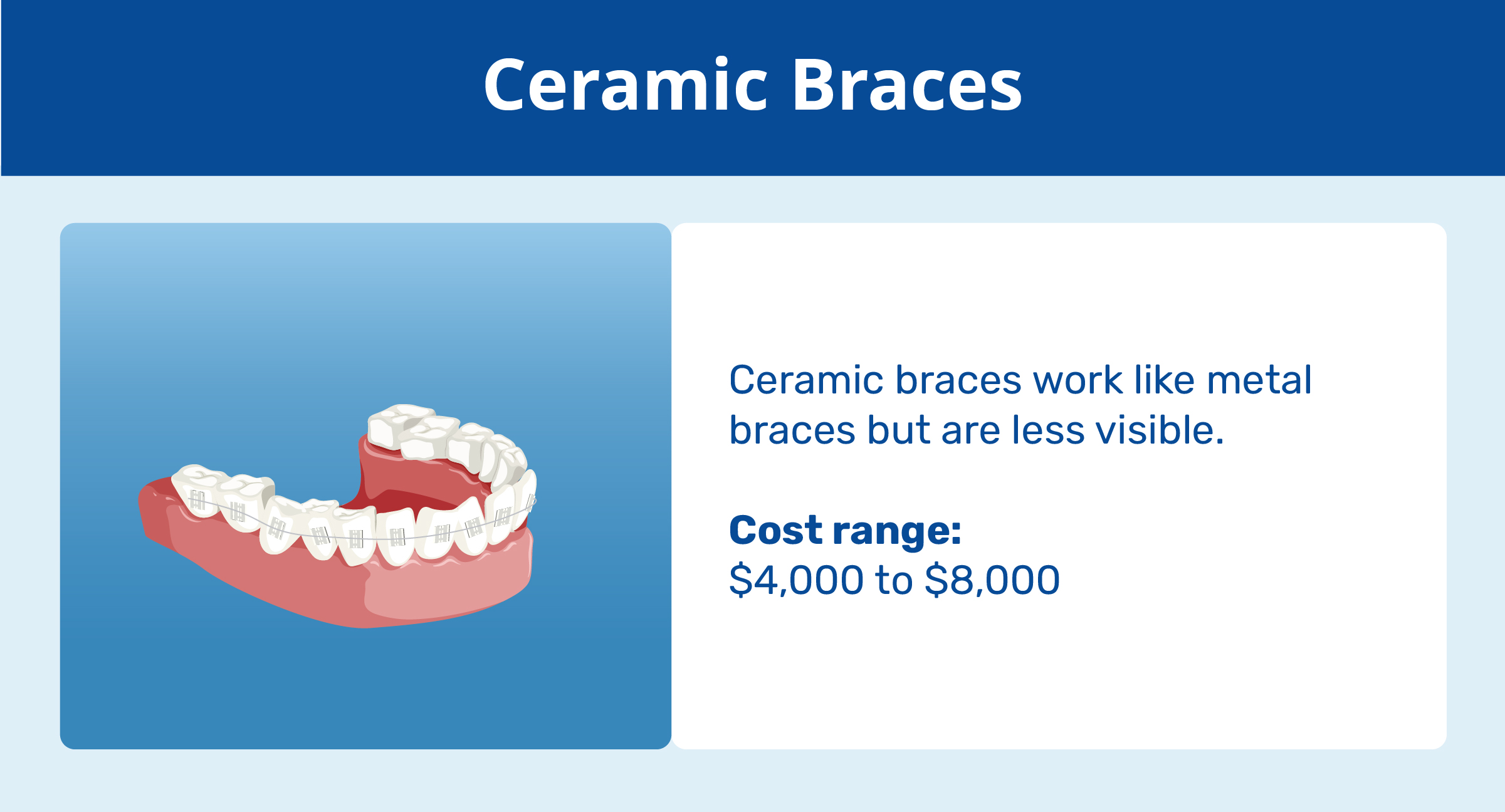
- The process: You follow the same steps as regular braces — an orthodontist consultation, braces fitting, and regular monthly appointments for wire adjustments.
- Cost range:
- $4,000 to $8,000 depending on your teeth misalignment
- May be partially covered by dental insurance, FSA, or HSA
- Timeline:
- 1 to 3 years with regular weekly visits for adjustments
- 1 to 3 years with regular weekly visits for adjustments
- Upkeep:
- You’ll need to visit your orthodontist monthly to get the wires adjusted to keep your teeth straight, just as you would with metal braces.
- You need to maintain good dental health habits, such as brushing and flossing.
- You’ll need to wear retainers after the braces come off to maintain straight teeth.
Lingual Braces
The difference between traditional metal braces and lingual braces is the placement location. Lingual braces are placed behind your teeth, so they are less visible.
These aren’t the best option if you have a deep overbite because that can put too much pressure on the braces and cause them to break off. However, even when placed on an ideal candidate, lingual braces may still impact how you talk because the braces are placed behind your teeth.
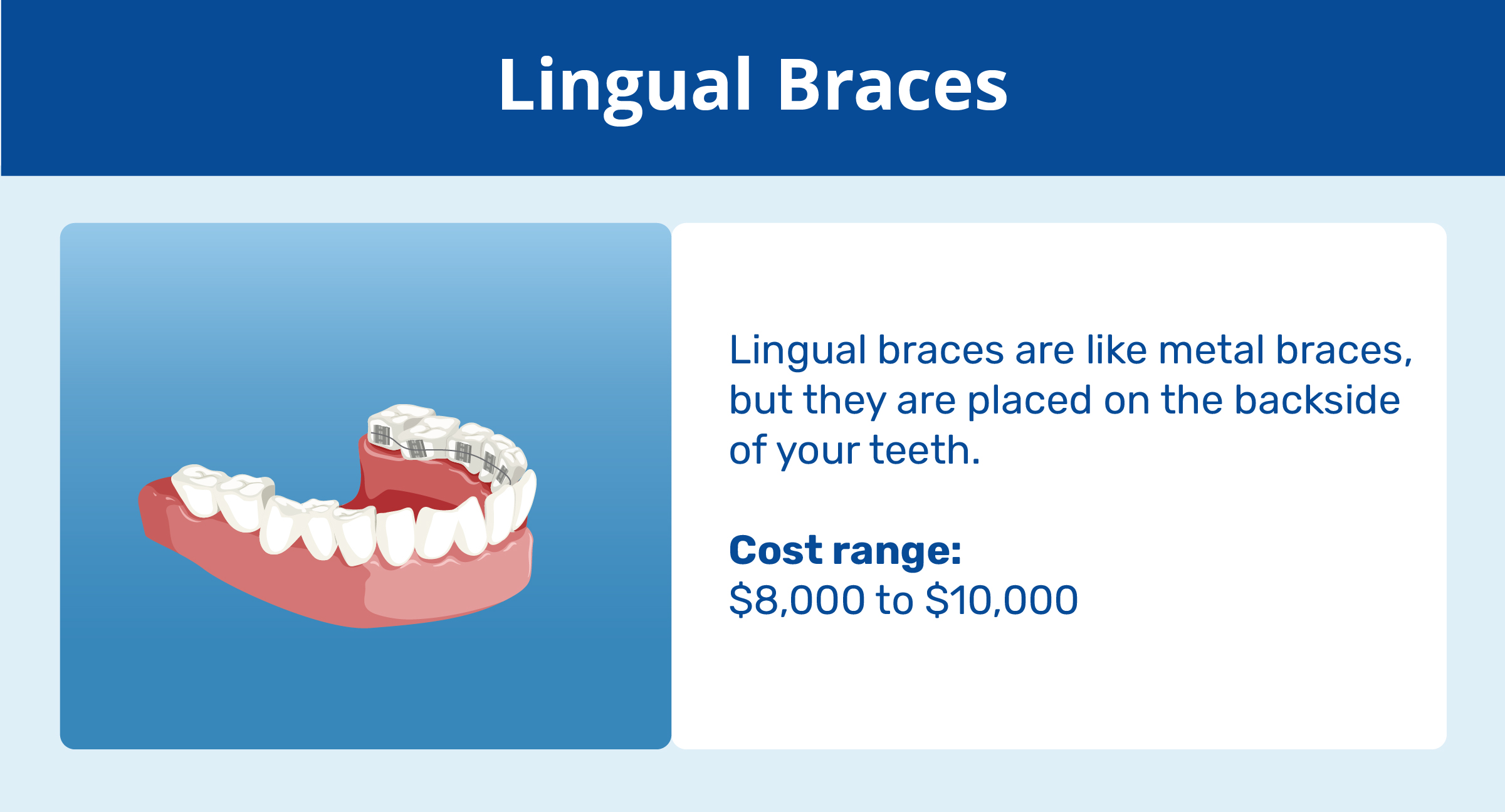
The process: You follow similar steps to conventional braces. Your dental professional takes an impression of your teeth, which is then sent to a dental laboratory and used to create customized brackets. Then, your orthodontist will cement the braces onto the back of your teeth. Lingual braces take the same amount of time as regular braces do to work.
- Cost range:
- $8,000 to $10,000 depending on your teeth misalignment
- May be partially covered by dental insurance, FSA, or HSA
- Timeline:
- 18 months to 3 years with regular weekly visits for adjustments
- 18 months to 3 years with regular weekly visits for adjustments
- Upkeep:
- You have to make regular orthodontist visits for adjustments.
- You need to maintain good dental health habits, such as brushing and flossing.
- You’ll need to wear retainers after the braces come off to maintain straight teeth.
Payment Plan Options for Straight Teeth
Some tooth straightening options are more affordable than others. If the costs of a treatment plan or procedure you need seem lofty, don’t worry — many providers offer payment plans to help you get the dental care you need. Here are some common financing options.
Online payment plans
Many online companies offer payment plans that allow you to pay monthly or biweekly, making the options more affordable. For example, Shiny Smile Veneers offers one time payment, two payment, or monthly payment options.
Payment plans from orthodontists
Orthodontists may offer payment plans with initial down payments and the remainder paid off in monthly installments, typically 12 to 24 months, interest-free. Alternatively, some offices may give you a discount for paying in full up front.
Dental insurance coverage
If you have dental insurance or are planning on getting a teeth straightening device, like braces or aligners, you may check and see if the plan or prospective plan would cover some of the costs and how much it would cover.
If you have dental insurance but are unsure of what would be covered, you can ask your dentist to submit an estimate before you move forward with treatment.
Flexible spending accounts (FSAs) and health savings accounts (HSAs)
If you have an FSA or HSA through your employer, you can use it for dental expenses like braces or aligners. This can help cover any portion of the cost not already covered by dental insurance or other medical insurance.
Get Your Shiny Smile Today!
Getting straighter teeth doesn’t have to break the bank, and you don’t have to wait months or years to have the white, bright, straight teeth you’ve been wanting. Order your snap-on veneers today to get your new and improved smile in just three to five weeks, so you can start smiling with confidence.
